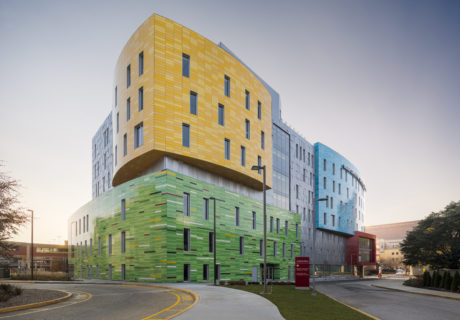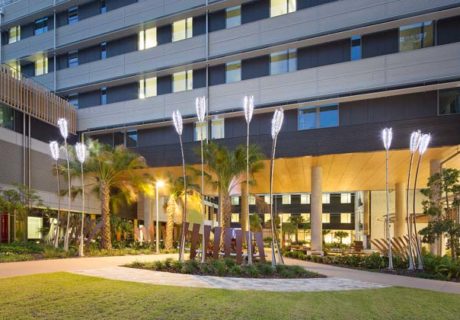Gardens Greet All 4 Seasons At Northeast Georgia Medical Center
Textural variety and colorful activity abound year-round in the Northeast Georgia Medical Center’s therapeutic gardens, thanks to the kinder, gentler weather of its Gainesville, Ga., location.
“For every season, if it’s bulbs, if it’s herbs, you’ve always got plantings. There’s really not a season that hasn’t been taken into consideration,” says Nancy Colston, president and chief development officer of The Medical Center Foundation, the fundraising arm of Northeast Georgia Health System. “In the fall, the elements of all the different textures and leaves appear. Even in the winter, the berries appear, and the texture continues. There’s always something to enjoy. The furniture, the sculptures, water—all of these are elements.”
It’s those details that helped four of the hospital’s gardens earn Gold in Healthcare Design’s second annual Landscape Architecture for Healthcare Communities awards program. (To view all of the projects submitted, see the October 2014 issue of Healthcare Design.)
Three of these gardens are adjacent to the Northeast Georgia Medical Center’s 128-bed surgical North Patient Tower, which opened in 2009; the fourth garden is intimately situated in the South Patient Tower complex located between a women and children’s pavilion and an outpatient infusion clinic. The four gardens, part of the hospital’s larger vision for developing its outdoor space, were dedicated from April 2009 to October 2013.
Recognizing that healing goes beyond the bedside, the hospital’s goal was to create outdoor environments that promote hope and healing for patients and families, visitors, staff, and the community at large. The concepts, designs, and materials used in these four gardens create a comforting environment for patients as well as all those around them who may be affected by an illness.
The planning for the four gardens began in tandem with the initial planning for the North Patient Tower; the foundation evaluated and identified outdoor destinations to enhance the campus but also to offer opportunities for signature gift-naming.
The conceptual designs for two of the gardens, Nell’s Prayer Garden and Wilheit-Keys Peace Garden, were developed by Stephan Sanchez, a principal with HGOR (Atlanta, Ga.), a planning and landscape architecture firm. Likewise, The Fockele Garden Co. (Gainesville, Ga.), a landscape design-build-maintain firm, completed the conceptual designs for the other two gardens, Anne’s Garden and The Pope Family Garden, as well as the planting designs and detailed plans for all four gardens.
Donor support for the gardens, including a maintenance endowment, was upwards of $2 million, with the initiative accomplished exclusively through philanthropy, Colston says.
Beyond financial support, the donors offered their personal experiences with gardening and a love of the outdoors to shape each garden’s features, right down to an heirloom climbing rose handed down over several generations and an old-fashioned blue mophead hydrangea—both donated and now thriving in Nell’s Prayer Garden.
“Each garden had to have some individuality,” says Mark Fockele, a principal and founder of The Fockele Garden Co. “But at the same time there had to be continuity between the gardens.” That continuity is achieved with planting selections, hardscaping, and furniture. The gardens also provide plenty of shade, enclosure, and privacy.
The competition jurors liked how the gardens provide significant places of respite for the facility, with numerous gardens at a single campus. The three gardens near the North Patient Tower allow users to meander; as visitors walk through one garden, they ultimately encounter the entrance to the next, encouraging them to seek what’s next. All gardens are fully accessible and have many benches and chairs distributed throughout to allow opportunities for rest.
Though open to all visitors, The Pope Family Garden is directly accessed from a labor and delivery waiting area and therefore designed to be a natural gathering place for expectant families, an outdoor destination where a newborn’s arrival can be awaited. Small cast-bronze animal sculptures are strategically tucked here and there for discovery by youngsters.
Another notable feature of the gardens overall is in the dozens of plants used throughout—more than 80 varieties in the Wilheit-Keys Peace Garden and 60 in Anne’s Garden. Color and texture, Fockele says, promote health and healing in simple ways. For example, old-fashioned or heirloom plants are catalysts for positive association of a childhood memory, while new and unusual plants might spark curiosity and closer examination—both results that can translate to feelings of relaxation, safety, and comfort.
To keep that plant variety from potentially overwhelming visitors, the design includes repetition—with purpose. Areas of the gardens are concentrated on one plant, creating “consistency and harmony in effect,” Fockele says. “Larger plantings of the same plant add simplicity and calm between those areas of activity and variety among plants.”
And it’s not just about the plant count and repetition. “You want a succession of prima donna plants that come along when it’s least expected and glorious,” Fockele says. One example is the crinum lily in The Pope Family Garden. “It takes only one or two of those to fill that prima donna slot. It’s terrific.”
The jurors appreciated the plant variety, as well as the articulation of a garden management strategy—a factor that’s sometimes overlooked.
“Continual maintenance is an issue for therapeutic gardens. Building in the garden maintenance through endowment, in perpetuity, is an innovative and sustainable way to allow these gardens to flourish and grow,” one juror notes.
And the gardens are starting to reach their stride. The Wilheit-Keys Peace Garden and Anne’s Garden have matured, with the plants now achieving a full and lush appearance, while Nell’s Prayer Garden and The Pope Family Garden, planted later, are beginning to fill in.
“Once a garden is planted, I almost always have a feeling of ‘this garden is better than I imagined,’” Fockele says. “Seeing the real thing is so much more powerful than imagining it.”
Sharon Schnall is a writer based in Northeast Ohio. She can be reached at schnallwriting@yahoo.com.




